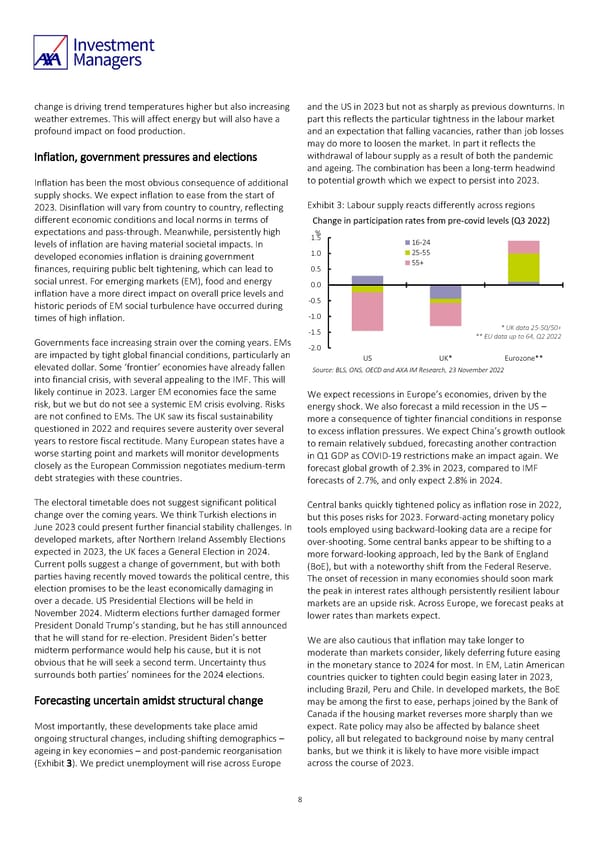change is driving trend temperatures higher but also increasing and the US in 2023 but not as sharply as previous downturns. In weather extremes. This will affect energy but will also have a part this reflects the particular tightness in the labour market profound impact on food production. and an expectation that falling vacancies, rather than job losses may do more to loosen the market. In part it reflects the Inflation, government pressures and elections withdrawal of labour supply as a result of both the pandemic and ageing. The combination has been a long-term headwind Inflation has been the most obvious consequence of additional to potential growth which we expect to persist into 2023. supply shocks. We expect inflation to ease from the start of 2023. Disinflation will vary from country to country, reflecting Exhibit 3: Labour supply reacts differently across regions different economic conditions and local norms in terms of Change in participation rates from pre-covid levels (Q3 2022) expectations and pass-through. Meanwhile, persistently high % levels of inflation are having material societal impacts. In 1.5 16-24 developed economies inflation is draining government 1.0 25-55 finances, requiring public belt tightening, which can lead to 0.5 55+ social unrest. For emerging markets (EM), food and energy 0.0 inflation have a more direct impact on overall price levels and -0.5 historic periods of EM social turbulence have occurred during times of high inflation. -1.0 -1.5 * UK data 25-50/50+ Governments face increasing strain over the coming years. EMs ** EU data up to 64, Q2 2022 are impacted by tight global financial conditions, particularly an -2.0 US UK* Eurozone** elevated dollar. Some ‘frontier’ economies have already fallen Source: BLS, ONS, OECD and AXA IM Research, 23 November 2022 into financial crisis, with several appealing to the IMF. This will likely continue in 2023. Larger EM economies face the same We expect recessions in Europe’s economies, driven by the risk, but we but do not see a systemic EM crisis evolving. Risks energy shock. We also forecast a mild recession in the US – are not confined to EMs. The UK saw its fiscal sustainability more a consequence of tighter financial conditions in response questioned in 2022 and requires severe austerity over several to excess inflation pressures. We expect China’s growth outlook years to restore fiscal rectitude. Many European states have a to remain relatively subdued, forecasting another contraction worse starting point and markets will monitor developments in Q1 GDP as COVID-19 restrictions make an impact again. We closely as the European Commission negotiates medium-term forecast global growth of 2.3% in 2023, compared to IMF debt strategies with these countries. forecasts of 2.7%, and only expect 2.8% in 2024. The electoral timetable does not suggest significant political Central banks quickly tightened policy as inflation rose in 2022, change over the coming years. We think Turkish elections in but this poses risks for 2023. Forward-acting monetary policy June 2023 could present further financial stability challenges. In tools employed using backward-looking data are a recipe for developed markets, after Northern Ireland Assembly Elections over-shooting. Some central banks appear to be shifting to a expected in 2023, the UK faces a General Election in 2024. more forward-looking approach, led by the Bank of England Current polls suggest a change of government, but with both (BoE), but with a noteworthy shift from the Federal Reserve. parties having recently moved towards the political centre, this The onset of recession in many economies should soon mark election promises to be the least economically damaging in the peak in interest rates although persistently resilient labour over a decade. US Presidential Elections will be held in markets are an upside risk. Across Europe, we forecast peaks at November 2024. Midterm elections further damaged former lower rates than markets expect. President Donald Trump’s standing, but he has still announced that he will stand for re-election. President Biden’s better We are also cautious that inflation may take longer to midterm performance would help his cause, but it is not moderate than markets consider, likely deferring future easing obvious that he will seek a second term. Uncertainty thus in the monetary stance to 2024 for most. In EM, Latin American surrounds both parties’ nominees for the 2024 elections. countries quicker to tighten could begin easing later in 2023, including Brazil, Peru and Chile. In developed markets, the BoE Forecasting uncertain amidst structural change may be among the first to ease, perhaps joined by the Bank of Canada if the housing market reverses more sharply than we Most importantly, these developments take place amid expect. Rate policy may also be affected by balance sheet ongoing structural changes, including shifting demographics – policy, all but relegated to background noise by many central ageing in key economies – and post-pandemic reorganisation banks, but we think it is likely to have more visible impact (Exhibit 3). We predict unemployment will rise across Europe across the course of 2023. 8
 AXA IM Outlook 2023 full report Page 7 Page 9
AXA IM Outlook 2023 full report Page 7 Page 9